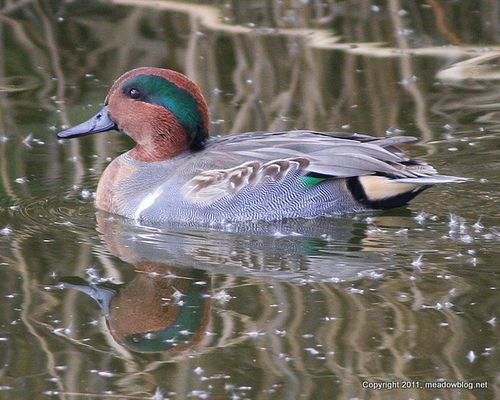
NJMC staffer Jim Wright, who keeps this blog, also writes a column every other Thursday for The South Bergenite. His latest, about the yearly increasing duck numbers in the Meadowlands, is below:
First came a Northern Shoveler or two in Harrier Meadow in North Arlington.
Then a couple of Northern Pintail started paddling around the Shorebird Pool in DeKorte Park in Lyndhurst.
Next came a small flotilla of Green-Winged teal, slurping up food in Secaucus’ Mill Creek Marsh.
While all of us were all busy with our autumn activities and chores, ducks have quietly invaded the Meadowlands again, joining our year-round resident mallard, gadwall and ruddy ducks.
If you are looking for another reason to be thankful on this Thanksgiving Day, consider: DeKorte Park is typically one of the best places to view these wintering waterfowl in our entire region.
Rest of column follows.
According to N.J. Meadowlands Commission Naturalist Mike Newhouse, the ducks migrate from the western plains, the Northeast, Canada and even Alaska to winter here in the Meadowlands.
What’s the attraction? “They come to the Meadowlands because of an abundance of food that comes in with the tide and is stored in some of our impoundments,” says Newhouse, who will help conduct Audubon’s annual Christmas Bird Count here next month. “There is also a healthy killifish population to support fish-eating ducks such as the three species of merganser — common, hooded, and red-breasted.”
In fact, the ducks are so numerous and varied that last winter we printed up a limited-edition DeKorte Duck Map. It includes helpful photo identifications of 12 species to help the public learn more about this amazing waterfowl population in their midst.
“The Meadowlands is a birding hotspot in the winter because you can see the regular winter waterfowl, with an outside chance of finding some more uncommon species,” says N.J. Meadowlands Commission Naturalist Mike Newhouse. “We sometimes see long-tailed duck and redhead.”
If you watch the ducks of DeKorte through a pair of binoculars, you’ll see that they are beautiful, colorful birds, and they are often easy to watch as they paddle about.
As the weather gets colder, the duck population and variety will continue to increase until early January, when rafts of hundreds and hundreds of Canvasback will winter in the tidal impoundments at DeKorte, and equal number of little ruddies will chill out in Little Ferry – at least until Mehrhof Pond freezes over, when they’ll head down to the Hackensack River.
The duck numbers should remain fairly high through mid-March. For example, a nature walk earlier this month at Mill Creek Marsh yielded six species, including a rare Eurasian Green-winged Teal. The same walk last March had at least nine kinds.
As for Newhouse’s favorite species of duck, the answer’s clear: “I like them all, but if I have to pick one I would have to choose the Long-tailed Duck because of their striking plumage. This species is much more common along the coast, but some make their way to the Meadowlands every winter.”

http://www.typepad.com/services/trackback/6a00e553bb7c20883401539375600a970b
How does one get access to Mehrhof Pond?